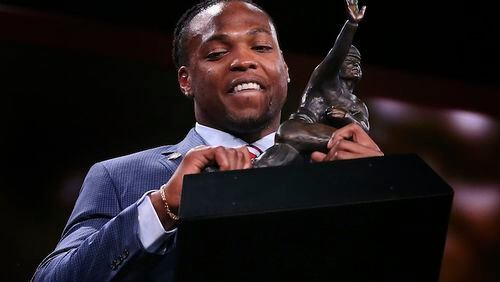When the winner of the Heisman Trophy was announced Saturday night on ESPN, the hefty bronze statue that was lifted in joy was not the original one first awarded in 1935.
That one is in an undisclosed, locked location, insured for $1 million. It no longer faces bright lights and reverent fans. Yet as recently as 2008, its handlers confessed that it had been secured somewhere in Battery Place in Lower Manhattan before it was moved to its permanent home at the nearby Sports Museum of America. But the museum shuttered quickly, and the trophy headed back into seclusion.
In the original’s place at the Heisman presentation at PlayStation Theater in Times Square were several younger clones, three of them in conspicuous spots on the set in view of ESPN’s cameras.
A new statue, the one that Alabama running back Derrick Henry is taking home, was finished two weeks ago in the Jostens foundry in Oklahoma City.
Before the ceremony, the contenders for the trophy said they cared little that they would not be embracing the exact Heisman that Jay Berwanger first won in 1935.
“I’ll be able to touch it by winning it,” Deshaun Watson, the Clemson quarterback, said philosophically on Friday as he, Henry and Christian McCaffrey talked to reporters at a Manhattan hotel.
McCaffrey, the Stanford running back, added: “I didn’t know that until now. I don’t think it will bother me too much.”
No old sports trophy shuns seclusion as much as the Stanley Cup, which travels the world with the players of champion National Hockey League teams during an off-season of celebration. The players eventually receive miniature models of the Cup. The take-home version that Heisman winners get is as close as possible to the first one, save for the wooden base, which is lighter than the original’s onyx.
Jostens, which is best known for making spectacular Super Bowl rings for the winning teams, produces two Heisman Trophies each year, one for the winning player and one for his university.
Chris Poitras, a vice president of the company, said that six craftsmen, all of them college football fans in Big 12 country, spent more than a month transforming the wax-filled trophy’s mold into a bronze statue that is darkened with a chemical patina and finished with a clear wax coating. The statue is actually cast in two pieces: one for the famous right arm figuratively fending off defenders and another for everything else.
“The arm is separate and is welded on to the rest of it,” Poitras said. “It’s necessary to get the absolutely perfect pitch to the stiff-arm.”
Jostens also sends the Heisman Trust nameplates of all the finalists, one of which is affixed with four little screws soon after the winner’s name is announced.
“When the athlete picks it up,” said Poitras, who estimated the weight of the trophy at 60 to 75 pounds, “I look at his face, and you can see from his expression that it’s heavier than he thought.”
The Heisman is not just for players and colleges. Throughout the years, it has served a purpose beyond honoring a great player’s season. “Although we don’t make this public, we have had a few trophies made over the years to use for marketing, and we’ve let sponsors like Nissan and Aflac use them,” said Rob Whalen, executive director of the Heisman Trust.
At least two of the statues that ESPN shows on the air have been used by sponsors.
The Heisman presentation has been held at various locations since ESPN began to carry it in 1994. The trophy’s longtime home was the Downtown Athletic Club, but when the Sept. 11, 2001, terror attacks forced it from its building, the ceremony shifted to the New York Marriott Marquis, the Yale Club and the New York Hilton before moving to what is now PlayStation Theater.
But the trophy — the true and original one — still has no permanent home.
The Heisman Room at the DAC, where the show had been held, was cramped and not an ideal television setting.
“Most of the people in the room would stay there and took the elevator to the 13th floor; there was a bar in the back that got used — but not by the crew,” Chris Fowler, ESPN’s host of all its Heisman shows, said during an interview at the theater.
Oil portraits like the ones once displayed in the Heisman Room have not been made of the winners since 9/11; those canvases are in storage now. Digitized replicas that use PhotoShop to turn photos of the winners into imitation oil paintings are now shown on television before they, too, are stored. On Friday, 41 of the portraits were on display at the theater, most of them flanking the stage. The addition of a giant screen meant the elimination of the portraits that were onstage last year.
This year, the usual hour-long program was to be extended to 90 minutes, from 8 to 9:30 p.m.
The added time “gives us a chance to tell more stories and talk more with coaches and family members,” said Michael Diesenhof, the producer of the broadcast. “The story lines are better this year.”
One story that was not told was that of Navy quarterback Keenan Reynolds. When he was still considered a likely finalist who had earned an invitation to the ceremony, Navy knew it would have to get him there in time after the Midshipmen played Army in Philadelphia. The plan was to fly Reynolds and eight others in two privately rented helicopters that were to take off at 7 p.m. from Philadelphia International Airport for a 41-minute flight to the West 30th Street Heliport in Manhattan. He was scheduled to arrive at the theater at 8:05, five minutes after the start of the show.
But only three finalists were chosen. And only Henry got the chance to wrestle the newest copy of the Heisman Trophy into the air.






